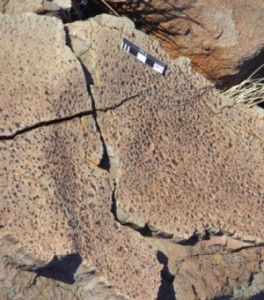The fossilised marks of raindrops that fell 2.7 billion years ago in South Africa have revealed the composition of the Earth’s early atmosphere.
According to a new study published in Nature today, the early Earth had an atmosphere with similar air pressure to the present day, but much higher levels of greenhouse gases. The findings, from a time when the Earth already had abundant microbial life, should improve our knowledge of what kinds of extrasolar planets might support life.
“Because early Earth was a planet very much alive, microbially speaking, having this second set of air composition [parametres] … will help scientists in the search for habitable worlds beyond our Solar System,” said lead author Sanjoy Som, an astrobiologist at the University of Washington in the U.S..
Cool Sun, warm Earth
Scientists have long been interested in the composition of the ancient atmosphere, because there is sediment evidence of oceans and flowing rivers between 2 and 4 billion years ago. This is despite the fact that the Sun was about 20% dimmer, which means the Earth should have been frozen at the time.
The extra warmth might have been provided by a higher proportion of greenhouse gases in the atmosphere, a denser atmosphere overall, or a combination of the two, but researchers couldn’t measure the air pressure and density of the ancient atmosphere to find out, Som said.
However, in 1851, British geologist Charles Lyell suggested measuring fossil raindrop imprints to estimate air pressure. The shape of a raindrop impression is affected by the density and pressure of the air it fell through, the velocity of the drop and the material it fell onto. A thicker atmosphere slows the velocity of the raindrop, and makes the resulting impression smaller.
Researchers know that raindrops more than 6.8mm across disintegrate while falling at terminal velocity, whatever the air pressure, so ancient raindrops should have been about the same size as today.
Measuring raindrops
Som’s team measured the imprints left by raindrops that fell on fresh volcanic ash in South Africa 2.7 billion years ago by making latex casts of 955 imprints and using a 3-D laser scanner to make detailed measurements. The team chose fossilised ash to be certain that their imprints weren’t just air bubbles, as might be found in fossilised mud or sand.
For present-day comparison impressions, the team dropped specific droplet sizes onto fresh ash from the 2010 Eyjafjallajökull eruption and weathered ash from Hawaii, from 27m up so that the drops reached terminal velocity.
Searching for life
If the biggest fossil impressions were formed by raindrops as large as the biggest raindrops possible today, then the atmosphere must have been no more than twice as dense as the modern atmosphere. In fact, because the largest raindrops are so rare today, it’s likely that the team didn’t find the largest ancient impressions, meaning the atmosphere was probably only a little denser than today, Som said.
The results also rule out very hot ocean temperatures and high carbon dioxide levels, Som said, so with an atmosphere not much denser than today but a much cooler Sun, the warmth of the early Earth must have been caused by a build-up of other greenhouse gases.
The early Earth was abundant in microbial life, so knowing that a very different atmospheric composition could still support life should help scientists searching for life on other planets, Som added.
Bradley Opdyke, a palaeoclimatologist at the Australian National University in Canberra, who was not involved in the study, said that the idea of using fossilised raindrop imprints was “fun and novel”, but plausible. “The idea and physics behind the article are quite sound,” he said.



 July 22nd, 2012
July 22nd, 2012  riffin
riffin 
 Posted in
Posted in 